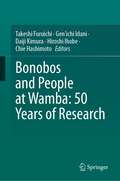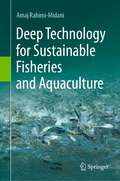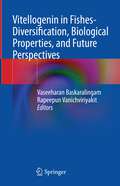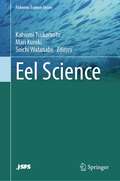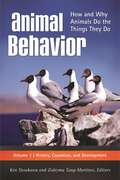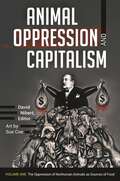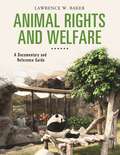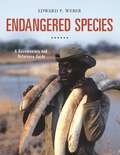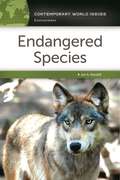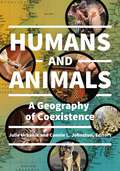- Table View
- List View
Bonobos and People at Wamba: 50 Years of Research
by Takeshi Furuichi Gen'Ichi Idani Daiji Kimura Hiroshi Ihobe Chie HashimotoThis book reviews all the findings about bonobos and the local people of Wamba village in the Luo Scientific Reserve in the Democratic Republic of the Congo over the last 50 years. In 1973, Takayoshi Kano, a Japanese primatologist, traveled across a vast area of the Congo Basin with a bicycle and found Wamba village to be a promising site to start his first studies on wild bonobos. Since then, many researchers from Japan and all over the world have been working at Wamba, now the longest standing study site, to uncover various aspects of the ecology and behavior of this most recently identified great ape species. The researchers study bonobo behaviors and carry out various activities for the conservation of bonobos. They also conduct anthropological studies of local people who live with bonobos and believe them to be distant relatives from the same family, living in the forest. This book is published in commemoration of 2023 marking the 50th year of study. The main chapters are contributed by active researchers studying bonobos and the local people at Wamba. The book also includes contributions from various eminent researchers who have carried out short-term research or have supported research at Wamba, which helps place these studies of bonobos in a broader primatological or anthropological perspective. This book will be a useful resource for professional researchers in primatology and anthropology, as well as graduate or undergraduate students interested in these research fields.
Deep Technology for Sustainable Fisheries and Aquaculture
by Amaj Rahimi-MidaniThis book uses real-world examples from the aquaculture industry to demonstrate how deep technology is assisting farmers and vulnerable communities. Works conducted by Poseidon-AI (a deep tech company involved in the aquaculture sector) in different countries are presented as case studies to show the positive impacts of deep tech involvement in the aquaculture sector. Primary industries, such as fisheries and aquaculture, rely heavily on labor. Furthermore, the manual practices of these farming methods increase material waste and reduce yields, resulting in higher costs and lower revenues. Poikilotherms make up the majority of aquatic animals, and environmental changes have a significant impact on them. This means that, due to climate change, farming of these animals cannot continue in the same way that it has for centuries. Artificial intelligence, machine learning, image processing, sensing, and automation are approaches that can assist these farms in dealing with rapid environmental changes while also assisting farmers in growing their businesses sustainably. This book is of interest to climate change scientists, entrepreneurs, investors, civil workers, and policymakers. Furthermore, the book is a great complimentary material for graduate students of fisheries, aquaculture, ecology, soil science, water management and environmental sciences. All national and international policymakers working in implementation of UNSDGs and sustainability, will find this book a useful read.
Vitellogenin in Fishes- Diversification, Biological Properties, and Future Perspectives
by Vaseeharan Baskaralingam Rapeepun VanichviriyakitThis book provides basic and advanced information on vitellogenin in fish. The proposed book discusses the history of vitellogenin, previtellogenesis, their diversification and classification in fishes, and tools for their identification and characterization. Further, their functional aspects in oogenesis and its regulatory mechanism, role as the immunocompetent molecule, and reproductive strategies are discussed. The book further examines vitellogenin as a hormone and biomarker, its related egg yolk proteins, and its mechanism on molecular cloning and induction. In addition, the book discusses its role in the disruption of the endocrine system in fish, its biological activities, its multivalent mechanism in marine and freshwater fishes, and its impact on the growth of ornamental fishes. Moreover, this book elaborates on the multiple vitellogenin genes, each with unique promoter regions and varying sensitivity to induction by estradiol, and multiple Vtg proteins themselves, with variable degrees of post-translational modification. As such, this book is helpful for researchers and students interested in the reproduction of fishes and reproductive biology.
Eel Science (Fisheries Science Series)
by Katsumi Tsukamoto Mari Kuroki Soichi WatanabeThis book is a compilation of eel research and fish migration studies for more than 40 years showing the research history and recent advances in eel studies. Dr. Katsumi Tsukamoto, the esteemed editor of this book, has been actively involved in eel research as one of the leading scientists in the world for a long time, and he and his team successfully collected the fertilized eggs and spawn-condition adult eels from the wild for the first time in the world. This book compiles the essentials of the scientific findings obtained by the editor and his colleagues and reviews the latest references of eel science. Knowledge and information in the book such as a spawning area survey, research on artificial production of glass eels, the discovery of a new species, etc. will attract the reader’s interest, as these are written based on the authors’ experiences. Readers can obtain a comprehensive understanding of eels from various aspects of eel science including the cultural and socio-economic importance of eels and valuable scientific information using state-of-the-art approaches. The book also endeavors to contribute to the conservation of eel species, some of which have been classified as endangered by the IUCN and to promoting harmonious coexistence between humans and nature.
Animal Behavior [3 volumes]: How and Why Animals Do the Things They Do [3 volumes]
by Alison M. Bell Andrew P. King Anna Dornhaus Anne Danielson-François Anthony C. Little Benedict C. Jones Bennett G. Galef Brett M. Gibson Brian Keane Bronwyn H. Bleakley Çağlar Akçay Carolynn L. Smith Catherine A. Marler Charles T. Snowdon Christopher D. Watkins Christopher Harshaw Christopher S. Evans David B. Mcdonald David Clark David Crews David F. Sherry David J. White Douglas W. Mock Geoffrey E. Hill George Uetz Guillermo Paz-Y-Miño-c James L. Gould Janis L. Dickinson Jason Low Jeffrey R. Alberts Ken Yasukawa Kenyon B. Mobley Laura Smale Lee Alan Dugatkin Lee C. Drickamer Lisa M. Debruine Mark E. Hauber Matthew J. Fuxjager Megan Hastings Hagenauer Meredith J. West Michael D. Beecher Michael J. Ryan Michelle Pellissier Scott Nancy G. Solomon Rachel A. Page Renée A. Duckworth S. Craig Roberts Sarah Jane Alger Sean P. Bradley Terry J. Ord Theodore Stankowich Walter D. Koenig Ximena E. Bernal Zenobia Lewis Zuleyma Tang-MartínezDiscover why animals do what they do, based on their genes, physiologies, cultures, traditions, survival and mating advantages, and evolutionary histories—and find out how studying behavior in the animal world helps us understand human behavior.The three volumes of Animal Behavior: How and Why Animals Do the Things They Do cover the breadth of the field, addressing causation, development, function, and evolution in a wide range of animals, from invertebrates to humans. Inspired by Nobel laureate Nikolaas Tinbergen's work, the first two volumes follow Tinbergen's four classic questions of animal behavior, while the third volume supplies integrated examples of Tinbergen's investigative process applied in specific cases.Written in an engaging, accessible manner ideal for college students as well as general audiences, this evidence-based collection provides a fascinating tour of animal behaviorists' findings, such as how animal communication can be truthful or deceitful, the deadly serious business behind clashes in the "battle of the sexes," and how documentation of animal behavior can lead to a deeper understanding of human behavior. Each chapter provides both historical background and information about current developments in animal behavior knowledge.
Animal Oppression and Capitalism [2 volumes]: [2 volumes] (Critical Perspectives On Animals: Theory, Culture, Science, And Law Ser.)
by David NibertThis important two-volume set unapologetically documents how capitalism results in the oppression of animals ranging from fish and chickens to dogs, elephants, and kangaroos as well as in environmental destruction, vital resource depletion, and climate change.Most traditional narratives portray humanity's use of other animals as natural and necessary for human social development and present the idea that capitalism is generally a positive force in the world. But is this worldview accurate, or just a convenient, easy-to-accept way to ignore what is really happening—a systematic oppression of animals that simultaneously results in environmental destruction and places insurmountable obstacles in the path to a sustainable and peaceful future?David Nibert's Animal Oppression and Capitalism is a timely two-volume set that calls into question the capitalist system at a point in human history when inequality and the imbalance in the distribution of wealth are growing domestically and internationally. Expert contributors show why the oppression of animals—particularly the use of other animals as food—is increasingly being linked to unfavorable climate change and the depletion of fresh water and other vital resources. Readers will also learn about the tragic connections between the production of animal products and global hunger and expanded regional violence and warfare, and they will understand how many common human health problems—including heart attacks, strokes, and various forms of cancer—develop as a result of consuming animal products.
Animal Rights and Welfare: A Documentary and Reference Guide (Documentary and Reference Guides)
by Lawrence W. BakerThrough the use of primary source documents, readers can learn about key opinions and legislation in the important field of animal rights and welfare—a current and highly relevant topic.Animal Rights and Welfare: A Documentary and Reference Guide addresses a broad range of key topics within the subject of animal rights and welfare, including zoos, animal testing, philosophy regarding the treatment of animals, and practical measures instituted to protect animals, supplying readers with an impartial and authoritative resource for understanding the history of animal rights and the issues that dominate discussions about animal rights. Organized chronologically, the book discusses topics such as animal rights within the context of hunting for food, pelts, and other body parts, as well as for recreation; working animals; animals used for education or scientific and medical research; animals in the fashion and entertainment industries; and the food industry.The text provides reproductions of dozens of carefully selected primary documents from the time of Aristotle (B.C.) to present day to engage readers and provide opportunities for them to apply their critical thinking and analysis skills. The text of each document is introduced by a headnote to place it in context and concludes with analysis that details its significance and clarifies specific passages when needed. Each document or excerpt is followed by a full citation of the document.
Endangered Species: A Documentary and Reference Guide (Documentary and Reference Guides)
by Edward P. WeberThis book uses primary documents as a lens through which to examine historical and present-day efforts to protect endangered species in the United States and around the world.In this thought-provoking work, author Edward P. Weber examines the values, policies, challenges, and approaches to endangered species conservation over the past 200 years. Using primary source documents and in-depth analysis of the issues, the reference tracks the evolution of species protection and conservation in the United States, and offers a brief look at global programs in the United States and other parts of the world. The book surveys how different countries are faring in protecting their plant and animal life, and considers which guidelines and programs hold the most promise for success in the future. Chapters compare and contrast past and present attitudes regarding endangered species and extinction and identify the influence of major organizations and individuals central to the debate over endangered species. Judiciously selected primary documents also explore the impact of species endangerment and loss on natural ecosystems—and ultimately, on humankind itself.
Endangered Species: A Reference Handbook (Contemporary World Issues)
by Jan A. RandallA detailed exploration of the variety of threats that endangered species are facing around the world, whether they are due to human impact or so-called natural causes.Endangered species is a more complex issue and problem than it may seem on the surface. What species are endangered, and what is causing them to become vulnerable to population decline? How can essential industries such as farming, housing development, and manufacturing continue to thrive without harming flora and fauna that are protected? Are current efforts adequate or should more be done to protect endangered species? And who should be responsible for the substantial costs of working to save endangered species?Endangered Species: A Reference Handbook begins with an introduction that addresses major threats and extinctions in history, discusses the geographical and cultural contexts in which these incidents happened, highlights other key moments along the endangered species timeline, and clearly shows why the topic of endangered species matters. The following sections examine an unbiased synthesis of classic and contemporary studies that inform the issue of endangered species and outline the most controversial events related to endangered species and the actions that have been taken to address them. The book also presents perspective essays by scholars, activists, and other experts to provide diverse informed opinions on the issue of endangered species and includes a data and documents chapter that applies research finding to provide answers to questions like what species are most likely to become endangered in the future and which practices have historically been the most effective at protecting vulnerable species.
Humans and Animals: A Geography of Coexistence
by Julie Urbanik and Connie L. Johnston, EditorsAn engaging and at times sobering look at the coexistence of humans and animals in the 21st century and how their sometimes disparate needs affect environments, politics, economies, and culture worldwide.There is an urgent need to understand human-animal interactions and relations as we become increasingly aware of our devastating impact on the natural resources needed for the survival of all animal species. This timely reference explores such topics as climate change and biodiversity, the impact of animal domestication and industrial farming on local and global ecosystems, and the impact of human consumption of wild species for food, entertainment, medicine, and social status. This volume also explores the role of pets in our lives, advocacy movements on behalf of animals, and the role of animals in art and media culture. Authors Julie Urbanik and Connie L. Johnston introduce the concept of animal geography, present different aspects of human-animal relationships worldwide, and highlight the importance of examining these interconnections. Alphabetical entries illustrate key relationships, concepts, practices, and animal species. The book concludes with a comprehensive appendix of select excerpts from key primary source documents relating to animals and a glossary.
